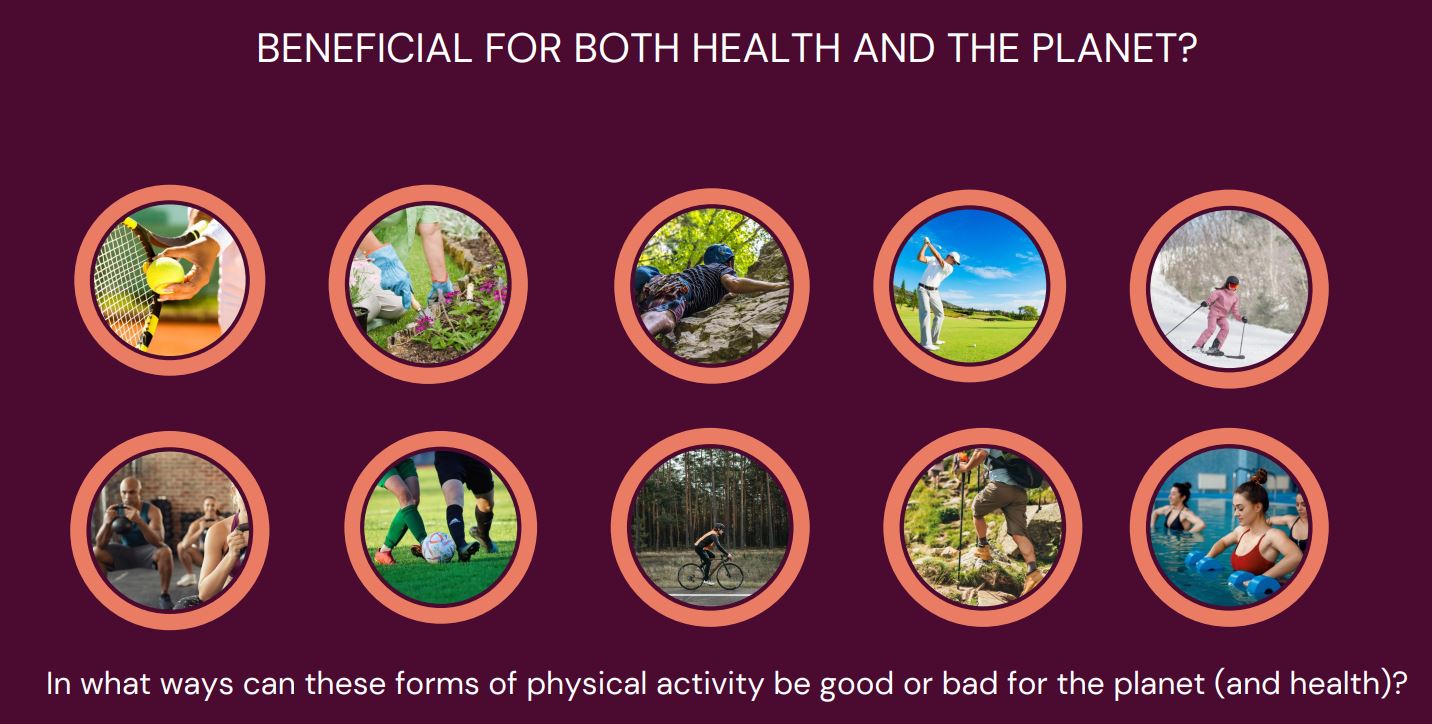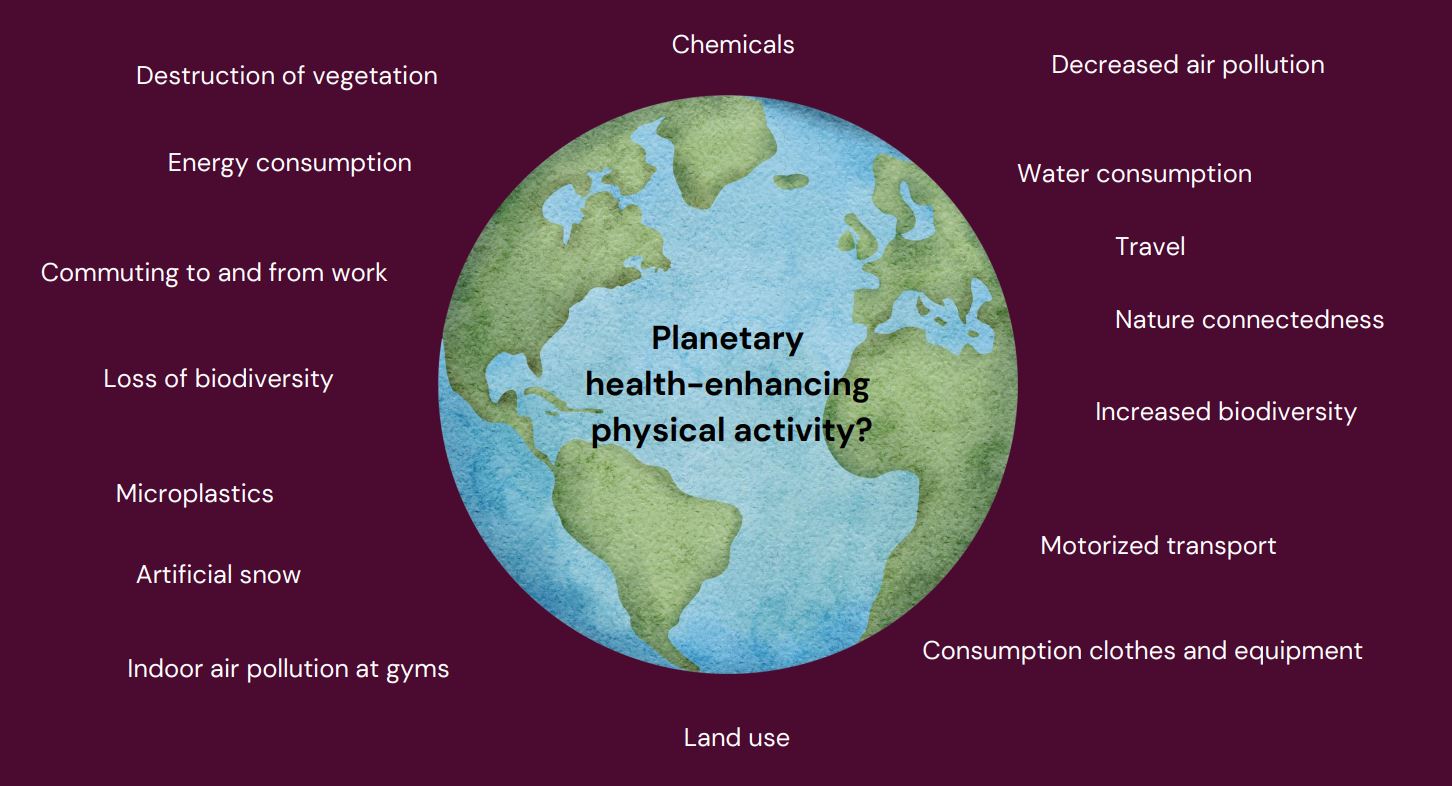
Planetary health-enhancing physical activity
Introduction
The Bachelor program in physiotherapy at Karolinska Institutet in Sweden, is a three-year full-time program comprising 180 ECTS. The program has 6 semesters during these three years. In each semester, except the 6th, there is at least one intended learning outcome related to sustainable development. In 2023, 5% (7 out of 135) of all intended learning outcomes in the whole program were sustainability-focused. Since then, some intended learning outcomes have developed and one more has been added. Already in the second week of semester 1, the students are introduced to sustainable development, the triple planetary crisis, planetary health, and briefly about sustainable healthcare.
The course and intended learning outcome
The learning activity described below takes place in the second semester (year 1), within the course Theme Intervention – Physiotherapy 2 and its module Physical Activity, motor control, and biomechanics. The intended learning outcome states that the student should be able to “analyze and discuss the promotion of physical activity in the context of the Sustainable Development Goals and relate this to the role of the physiotherapist in health care”.

The learning activity
The learning activity consists of an interactive overview lecture and discussion lasting 1.5 hours. In spring 2025 the learning activity has been carried out 4 times, with each run including refinement and revisions.
The lecture starts with an overview and repetition of the sustainable development goals and a discussion on physical activity´s role in sustainable behavior (1) and how increasing physical activity will directly contribute to 13 out of 17 SDGs according to the “Global Action Plan on physical activity 2018–2030: more active people for a healthier world” by WHO (2).

Emma Swärdh (PhD)
Assistant Senior Lecturer, Karolinska Institutet, Sweden
Emma is dedicated to teaching and learning for sustainable development, planetary health, and sustainable healthcare at the undergraduate physiotherapy program. She also has an assignment as an environmental- and sustainability representative and is a member of the Council for Environment and Sustainable Development at KI. Her research centers around education for sustainable development in undergraduate physiotherapy education in Sweden.

Moving forward, and using the planetary boundaries framework (3), the rest of the lecture will focus on the environmental dimension of sustainable development and humans’ disconnection from nature (4) in promoting physical activity. During the autumn semester of 2024, nature connectedness was included in the learning activity for the first time. What benefits might the connection with nature or green spaces during physical activity provide human health and how might this affect the environmental dimension of sustainable development? Physical activity is then discussed from three perspectives; physical activity as a victim, a perpetrator, or part of the solution to the triple planetary crisis (5-6), as well as how we as physiotherapists can and should change our physical activity interventions to align with the crisis we are in.
Adaptation strategies, especially for vulnerable people, such as how to deal with extreme heat or other extreme weather events in physical activity promotion, are discussed. However, restricting our response to the triple planetary crisis solely to adaptation overlooks the positive and negative contributions of physical activity to the crisis. Many types of physical activities have significant negative environmental impacts, including carbon emissions, resource consumption, and ecological degradation, while others inherently offer benefits for both human and planetary health (7-10). Thus, a significant part of this interactive lecture is dedicated to discussing the possible dark side of physical activity, whether or not physical activity is always sustainable for the planet, and which types of physical activities might be beneficial for both human health and the planet. After the students have identified the downsides of different types of physical activities such as fertilizer use, motor vehicle transportation, water usage, and energy demands, as well as the broader effects on ecosystems – active transportation – as a way to increase health and mitigate emissions from motorized vehicles is highlighted and discussed from a physiotherapy perspective (11-12). The lecture ends with a short discussion on the role of physiotherapists in communicating/advocating for planetary health-enhancing physical activity to patients and the general public by, for example, debating, writing commentaries, developing policies, or guidelines, as well as cooperating with other professions or organizations.
Assessment of the learning activity
The learning activity is mandatory and different interactive tools are used such as Mentimeter as well as oral group discussions to enhance deliberation and critical reflections. Wordcloud is used after each lecture to provide the students with the opportunity to express what they bring with them in a few words.
References used for the learning activity
- Nigg, C., & Nigg, C. R. (2021). It’s more than climate change and active transport—physical activity’s role in sustainable behavior. Translational behavioral medicine, 11(4), 945-953.
- World Health Organization. (2028). Global action plan on physical activity 2018–2030: more active people for a healthier world. WHO. Geneva.
- Rockstrom, J., Gupta, J., Qin, D., Lade, S.J, Abrams, JF., Andersen, LS., et al. (2023). Safe and just Earth system boundaries. Nature, 619:102-111.
- Barragan-Jason, G., Loreau, M., de Mazancourt, C., Singer, M. C., & Parmesan, C. (2023). Psychological and physical connections with nature improve both human well-being and nature conservation: A systematic review of meta-analyses. Biological Conservation, 277, 109842.
- Lengieza, M. L., & Swim, J. K. (2021). The paths to connectedness: A review of the antecedents of connectedness to nature. Frontiers in Psychology, 12, 763231.
- Gelius, P., Messing, S., Tcymbal, A., Birkholz, L., & Abu-Omar, K. (2024). Physical Activity as a Victim, a Perpetrator, or Part of the Solution to the Climate Crisis?. Journal of Physical Activity and Health, 1(aop), 1-3.
- Siefken, K., & Abu-Omar, K. (2023). Striking a balance: physical activity and planetary health. Journal of Physical Activity and Health, 20(12), 1081-1083.
- Abu-Omar, K., Chevance, G., Tcymbal, A., Gelius, P., & Messing, S. (2023). Physical activity promotion, human and planetary health–a conceptual framework and suggested research priorities. The Journal of Climate Change and Health, 13, 100262.
- Abu-Omar, K., Gelius, P., & Messing, S. (2020). Physical activity promotion in the age of climate change. F1000Research, 9, 349.
- Bernard, P., Chevance, G., Kingsbury, C., Baillot, A., Romain, A. J., Molinier, V., et al. (2021). Climate change, physical activity and sport: a systematic review. Sports medicine, 51, 1041-1059.
- Toner, A., Lewis, J. S., Stanhope, J., & Maric, F. (2021). Prescribing active transport as a planetary health intervention–benefits, challenges and recommendations. Physical Therapy Reviews, 26(3), 159-167.
- Jochem, C., & Leitzmann, M. (2023). A call for integrating active transportation into physical activity and sedentary behaviour guidelines. The Lancet Planetary Health, 7(2), e112-e113.

0 Comments